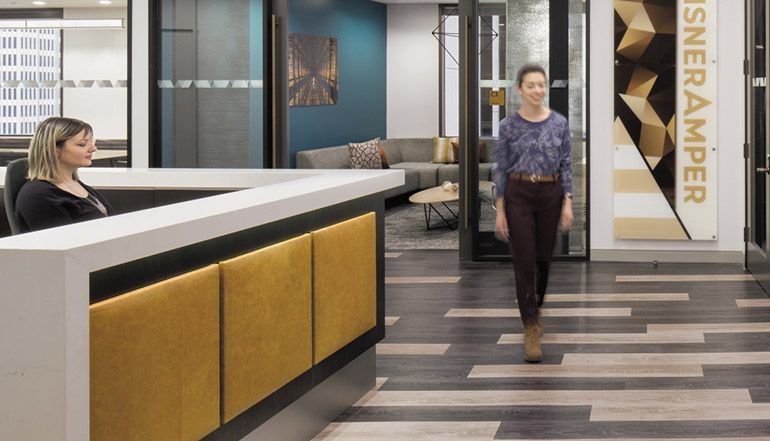The fastest-growing sector of the flooring industry is the manufacturing and distribution of commercial SPC flooring products. However, this recent addition to the arsenal of resilient commercial floors is still surrounded by confusion among the various market players, i.e., producers, sellers, and buyers.
For starters, the acronym “SPC” is often described differently. Depending on where one receives their information, be it online demo videos or blog articles such as this one, there are different interpretations of what SPC stands for.
The “S” is either solid or stone, the “P” is either plastic or polymer, and the “C” is either component, composite, or core.
So, what does SPC stand for in flooring? The clearest and most accurate definition for what SPC stands for is Stone Plastic Composite. It is called this due to the composition of the core layers; it is a polymer made of stone and plastic. The composite of stone and plastic allows SPC floors to retain the best qualities of other luxury vinyl floors, such as LVT and LVP, while adding improved functionality in terms of strength and resistance.

So, what type of flooring is SPC exactly? Stone Plastic Composite floors are a type of rigid core flooring. Rigid core flooring also includes other floors, such as WPC and hybrid floorings. The main defining characteristic of rigid core flooring is that some sturdy material, typically stone or wood, is added to the plastic vinyl core.
Rigid core floors and luxury vinyl floors are the latest in vinyl flooring technology and are designed to fit within the category of resilient flooring, particularly resilient commercial flooring. Therefore, SPC flooring is a specific type of rigid core flooring product that comes from the vinyl flooring family and fits the standards of resilient commercial flooring.
So, how is SPC actually made? The first stage of SPC production is mixing the stone and plastic materials in high temperatures. This eliminates every last bit of water or moisture inside the raw materials. Once properly cooled down, the mixed composite is ready for the next stage, known as “extrusion.” This process takes the mixture of materials and runs it through five areas of strict temperature control.
When done correctly, the materials undergo “plasticization” and are molded. Once the mold has become completely plasticized, it is ready for “calendering.” This process involves passing materials through rollers known as “calenders” (not to be confused with “calendars”). The different manipulations of these calender rollers allows the material to be thinned into continuous sheets of varying thicknesses and widths. These advanced heat rollers grant SPC producers an incredible amount of accuracy in creating different specifications of SPC floors.
Once passed through the calender rollers, the material is drawn towards the photoelectric cutter. Here, it is cut into precise, congruent sections according to the specifications desired. If the final crosscut is considered up to par, an automated lifter safely stacks up the finalized SPC tiles or planks.
SPC tiles and SPC planks are composed of distinct layers. Some of the layers are incorporated into the production process while other layers, particularly different finishes and coatings, may be added via extra processes.
Most commonly, SPC flooring is made up of the following four layers: wear layer, vinyl layer, rigid core, and backing layer. The wear layer is the topmost portion, and it contains the material(s) and coating(s) most responsible for resistance to surface damage. The vinyl layer is where the 3D printed visuals are inserted. The rigid core is where the magic happens; it is where the stability, rigidity, durability, and waterproof qualities are found. The backing layer can vary according to installation styles, but it is where underfoot cushioning and acoustic control materials can be added to. It is most responsible for fighting mold and mildew growth, thereby protecting your subfloor.

Top 3 Benefits of Commercial SPC Flooring
1. Pricing
SPC floors are generally considered as the most cost-effective commercial flooring materials out on the market. This does not mean it is the cheapest or most affordable, however. It merely means that of all the commercial flooring products available, SPC offers the best cross-section of price and efficiency.
On average, SPC is about $1 more expensive than LVT or LVP (per square foot) but is about $1 less expensive than WPC (per square foot). It is also generally much cheaper than hybrid rigid core floors.
However, it offers far more protection than the usual LVT or LVP flooring product and performs quite similarly to WPC and hybrid floors; in some cases, it may even outperform these competitors.
When it comes to commercial flooring, SPC excels at fitting a broad spectrum of flooring needs for various commercial operations. If price is not a concern, then the various finishes and coatings available allow SPC to fit almost any challenging commercial environment.
2. Temperature Fluctuations
Speaking of challenging environments, SPC is widely considered to grant the biggest “bang for your buck” because of its unique ability to resist temperature fluctuations. If a commercial or industrial operation is challenged by the range of temperature or climate conditions that its floors experience, then SPC is the only choice. It far exceeds the performance capabilities of other floors in any environment experiencing a range of temperature fluctuations.
3. Dent Resistance
Not only is SPC the best rated at resisting temperature fluctuations without suffering any damage, but it is also the most resistant to dents. While other resilient floors can resist all manner of surface damage, there is one type of surface damage that most resilient floors still have a hard time dealing with.
Indentations in flooring caused by heavy furniture or large equipment is still a challenge for many types of resilient commercial floors. SPC is the best resilient commercial floor for preventing irreparable dents into flooring. This is a crucial element since many warehouses and commercial/industrial facilities frequently deal with heavy pieces of furniture and often operate large machinery on a daily basis.
Is Commercial SPC Right for You?
If you are a commercial owner or industrial operator and are interested in installing SPC flooring for your facilities, we here at Europine would love to start that conversation and help you get rolling in choosing the right flooring product for you. We can help you navigate the various SPC products and options available to suit any of your resilient commercial flooring needs.
Want to know more about SPC flooring?
Europine indeed prides itself on delivering nothing but the best available on the market. However, nothing makes us happier than merely helping people solve their problems. If your interest was piqued by this blog or if you have a more serious inquiry regarding becoming a happy owner of SPC flooring, please contact us for more information, and we’ll gladly create a dialogue to help you navigate the flooring market.
